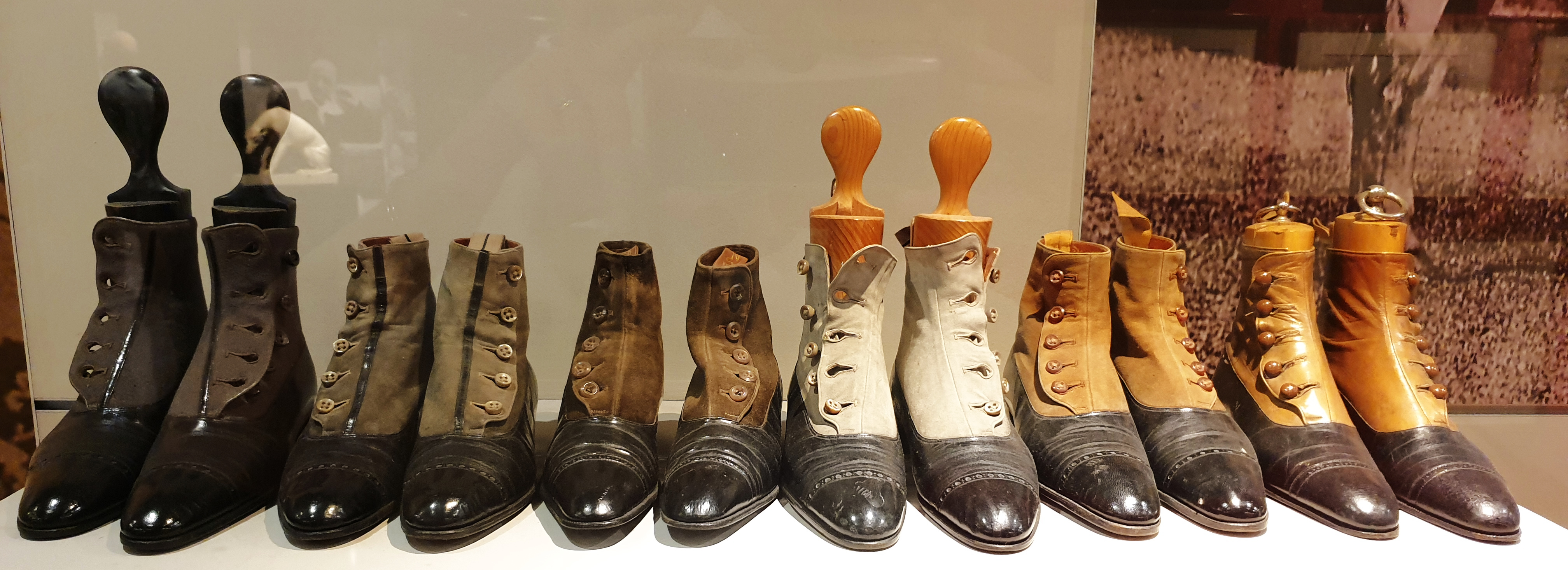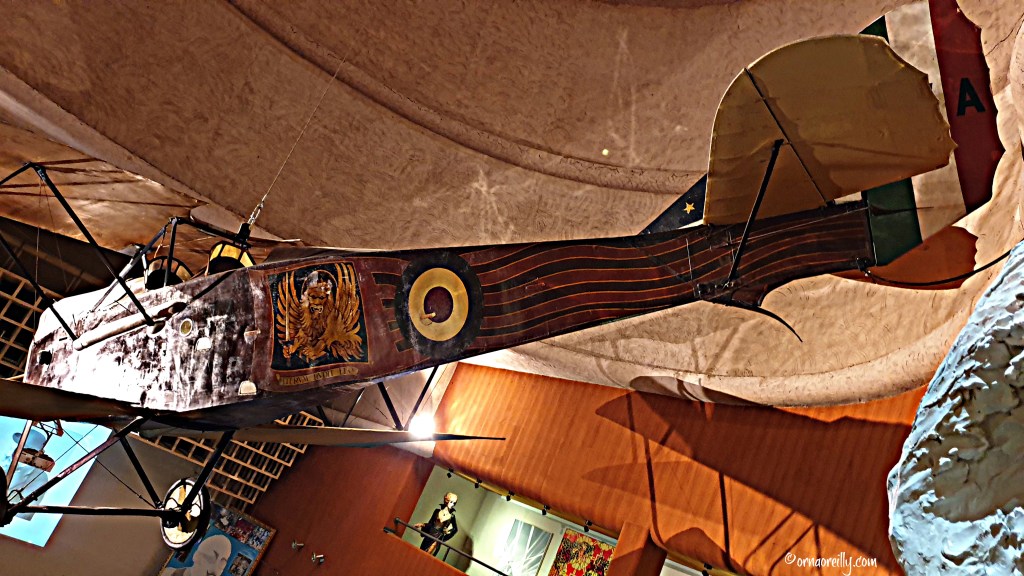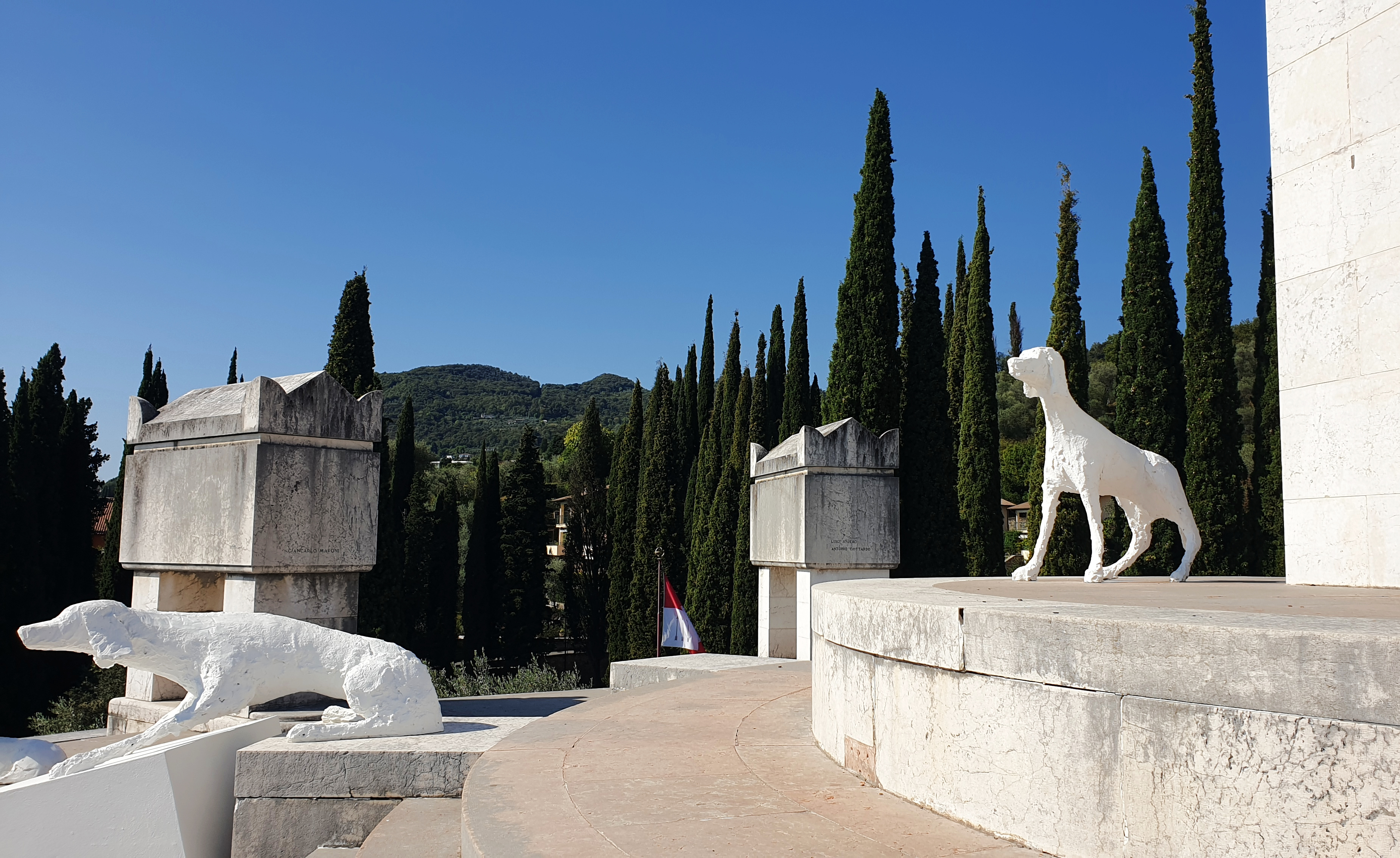
Having recently spent two weeks in the elegant town of Salò on Lake Garda in northern Italy, the most interesting place that my husband, Tom, and I visited was the Vittoriale, the final home and resting place of the great Italian poet, Gabriele D’Annunzio.
Le Vittoriale degli Italiani (The Shrine of Italian Victories) is located on a hill above Gardone Riviera on the south western shore of Lake Garda in the province of Brescia in northern Italy.

It is perched on a hillside with remarkable views of the lake and mountains and is open to the public, visited by about 180,000 people every year.


Having booked online on their website, upon our arrival, we were directed to the Priory for a guided tour. D’Annunzio lived in this house for the last seventeen years of his life.
The facade of the Priory is adorned by several coats of arms and two frescoes which were uncovered during its early renovation.

The Poet’s eccentricity is immediately obvious in the gloomy, densely furnished rooms. Black lacquer with lots of gilding, bathroom fittings in lapis blue, heavy drapes and stained glass windows block the light. The rooms are packed with countless busts, velvet chairs, figurines, vases, tapestries, bookshelves crammed tightly: all items that D’Annunzio collected over many years. Seemingly randomly placed and untidy, he apparently spent a great deal of time arranging everything to his satisfaction and preferred the darkened rooms due to having lost an eye during the war.
Gabriele D’Annunzio, born in 1863, was an extraordinary and complicated man with a vivid imagination and a constant thirst for action and adventure. Revered in Italy, some of his works are still taught in school, though his reputation was somewhat darkened by his association with fascism.
In 1919, D’Annunzio had installed himself in an apartment in the royal palace in the city of Fiume – now Rejeka, Croatia – where he was idolised as a ruler and dictator.
Eventually, D’Annunzio surrendered. He had openly defied the Italian Government and was sent to live under virtual house arrest on the shores of Lake Garda under close supervision for the rest of his life.
Villa Cargnacco, now the Priory, was an eighteenth century farmhouse which had been left behind by a German family, relatives of Listz and Wagner, who had been dispossessed after the war. D’Annunzio moved in during 1921 and spent the rest of his life transforming it.
In September 1922 D’Annunzio fell from a first floor window and fractured his skull. There have been many theories written over the years to try to explain this, but nothing has ever been proven. He had been sitting on a window seat when he fell. Was he pushed? Did he fall? Nobody knows.
In December 1923, D’Annunzio donated the house to the Italian State and a year later it was declared a national monument.
The Vittoriale degli Italiani is a warren of buildings joined by streets, squares, gardens, lakes and an open air amphitheatre, all conceived by D’Annunzio and designed by architect Gian Carlo Maroni.

We soon discovered a fascinating museum called “The Secret D’Annunzio”. Opened in 2010, it contains many of his personal belongings. These include several well tailored suits and umpteen pairs of neat little shoes. D’Annunzio was only five feet tall, fastidious in the extreme and a dapper dresser.


Moving along to the open-air amphitheatre, where concerts are performed on a regular basis. D’Annunzio and Maroni did not live to see it in action, as it was only completed in 1952. It has been extensively upgraded since then and it is perfectly positioned, with the tiers of seats looking out over the lake.


Another museum, the Schifamondo, houses the exhibition called “D’Annunzio the Hero” and exhibits include his death mask and many mementos, including a book of letters by St. Catherine of Siena, which he brought with him as a talisman on his famous flight over Vienna in 1918, when he dropped thousands of leaflets calling on the Austrians to surrender during the war.

The little plane in which he was transported over Vienna now hangs in the auditorium. Around the upper level of the auditorium is a collection of paintings by modern Italian artists. I was delighted to see that a painting of some of D’Annunzio’s many dogs was painted by my friend Maurizio Boscheri.

Another souvenir from D’Annunzio’s wartime adventures is housed in a specially designed hangar. It is a MAS 96 torpedo-armed motorboat that he used in a nighttime raid. For a while it was docked at Torre San Marco, and was used by the Poet to ferry guests up and down the lake.

One of the most fascinating things to see at the Vittoriale is a battleship called the Royal Ship Puglia, set into the hillside with its prow looking out over the lake.. It was transported there on twenty railway carriages and reassembled on site. D’Annunzio loved to fire its cannons on special occasions.

From there it is an idyllic stroll through little valleys, along walkways and over bridges, while taking in the natural vegetation, streams and waterfalls along the way.

Towering over the entire complex is an austere mausoleum which consists of D’Annunzio’s sarcophagus raised on a plinth, surrounded at a lower level by ten further sarcophagi occupied by some faithful friends, including the architect Maroni.


On March 1st 1938, D’Annunzio died suddenly at his desk in the Priory of a cerebral haemorrhage. He lay in state on the deck of the Puglia and was eventually entombed at the top of the mausoleum..
A more detailed version of this article will be published in art, literature and travel magazine Anthology in their spring edition. To have a look at their website, click HERE.
Orna O’Reilly
Ostuni, Puglia
Italy
Hi Orna –
Spent some time in Salò a couple years ago as a home base on Lake Garda. Was not aware of the Vittoriale nor ventured there. Thanks for the excursion.
On Thu, Jan 6, 2022 at 7:25 AM Orna O’Reilly: Travelling Italy wrote:
> orna2013 posted: ” Having recently spent two weeks in the elegant town of > Salò on Lake Garda in northern Italy, the most interesting place that my > husband, Tom, and I visited was the Vittoriale, the final home and resting > place of the great Italian poet, Gabriele D’Ann” >
You absolutely must return and visit this remarkable place. I have just finished an in depth biography on D’Annunzio and could have written a lot more. A fascinating subject. I would strongly recommend that you read up on D’Annunzio before you visit. It will put everything in context, otherwise it’s confusing. Nice to hear from you. Any Italian trips planned for this year?
Excellent article Orna! Thank you!
Dermot
I’m so glad you enjoyed it. D’Annunzio was a fascinating character. Only 5ft tall but larger than life. I could have happily written a few thousand words on the subject, but blogging these days means keeping the wording to the minimum, unfortunately.
Brilliant, love to visit you there so hurry up and move . Xx
Sent from my iPhone
>
Lake Garda is one of my favourite places on the planet. You’ll have to visit when we’re there. X
Wow, that’s a fantastic place with wonderful views! My favorite shot is your very first one through the round window. Happy New Year to the two of you.
janet
Happy New Year to you too Janet. Lake Garda is a truly magical place.
Very interesting. You described the interior of his house the way I felt reading “L’innocente” – gloomy, to say the least. There was such a negativity, a wallowing in self and a disdain for women coming off the page that when I finished it, I closed the book on the man. His shoes, yikes!
Yes. I didn’t want to upset his many fans – they are legion here – and say anything negative. He was, quite frankly, weird. I read an in depth biography recently called “The Pike” which was very interesting. There was so much more I could have written, but most people won’t read a long detailed article these days. As I’m sure you know!
So true. And I must admit that the fact that such aggressive narcissism can transform into a cultural esthetic is beyond my scope of understanding, anyway. However, even though I don’t subscribe to “Dannunzianesimo,” I still throw around the undocumented quote that he once said Reggio Calabria’s waterfront was the most beautiful kilometer of Italy!